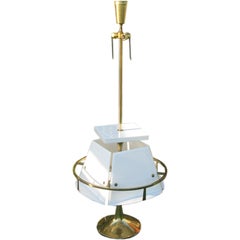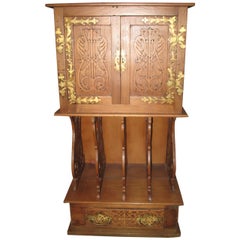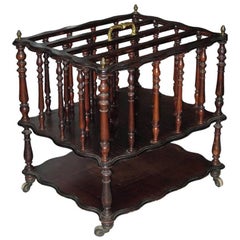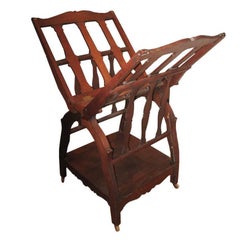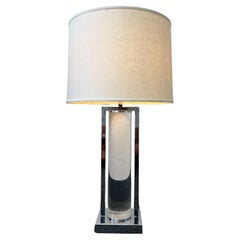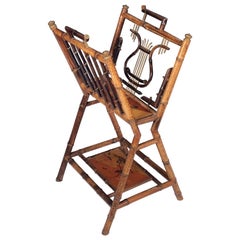Eclectiques Racks and Stands
to
4
4
3
1
1
1
3
3
3
1
1
3
2
1
1
1
4
4
4
Charles Hollis Jones Revolving Lamp/Magazine Rack
By Charles Hollis Jones
Located in Water Mill, NY
Rare Charles Hollis Jones Midcentury brass and beveled opaque white Lucite revolving lamp/magazine rack with custom shade.
Category
Vintage 1960s American Floor Lamps
Materials
Brass
19th Century American Music Cabinet
Located in Water Mill, NY
19th century American sheet music cabinet with brass hardware.
Category
Antique Late 19th Century North American Music Stands
Materials
Brass
19th Century Rosewood Magazine Stand/Canterbury
Located in Water Mill, NY
19th Century Rosewood Canterbury/Magazine Holder with Under Shelf, Wood Wheels, Brass Handle and Finials
Category
Antique 19th Century English Magazine Racks and Stands
Materials
Brass
19th Century Folio Stand
Located in Water Mill, NY
Late 19th century walnut folio stand with under shelve and wooden wheels. Measures: 48" open.
Category
Antique 19th Century American Magazine Racks and Stands
Materials
Walnut
$2,800
Related Items
Lucite and Chrome Table Lamp by Charles Hollis Jones
By Charles Hollis Jones
Located in Palm Springs, CA
Rare 1970’s Lucite Lamp and polished chrome table lamp by American renowned designer Charles Hollis Jones.
New vanilla linen shade and newly rewired.
Wire for US. It takes two 75...
Category
Vintage 1970s American Modern Table Lamps
Materials
Chrome
English Bamboo Canterbury Music Rack or Magazine Stand
Located in Austin, TX
A fine English bamboo Canterbury music stand or magazine rack featuring a bamboo stand with a lyre design in bamboo, with lacquered chinoisierie panel under-tier and stretcher base, ...
Category
Antique 19th Century English Music Stands
Materials
Bamboo, Wood, Lacquer
19th Century French Side Table
Located in High Point, NC
19th century walnut side table from France with a beveled and hand carved decorated edge around the top, following down to a fabulously hand carved apron on all four sides of the tab...
Category
Antique 19th Century French Napoleon III Side Tables
Materials
Walnut
English Victorian Walnut Music Cabinet / Drinks Cabinet
Located in Whaley Bridge, GB
Sn5630 Finest quality antique Victorian pedestal drinks cabinet / music cabinet in burr and figured walnut, having oversailing top with rounded and moulded edge above a cabinet door ...
Category
Antique 19th Century English Music Stands
Materials
Walnut
$2,478 Sale Price
20% Off
H 41.14 in W 20.08 in D 15.35 in
19th Century English Bamboo Table
Located in Nashville, TN
This is a beautiful 19th century English bamboo side table! Tables like these make excellent accent pieces because their color and style is so versatile.. These tables fit wonderfull...
Category
Antique 1880s English End Tables
Materials
Bamboo
French 19th Century Easel
Located in Stockbridge, GA
This 19th century Easel is made of oak and has 4 wheels at the feet which make it easier to move it.
when the support for the painting is positioned at its lowest, the height is 51''...
Category
Antique Mid-19th Century French Easels
Materials
Oak
Napoleon III Porte Revue/Magazine Stand/Canterbury
Located in Trensacq, FR
Stylish French Napoleon III 'porte revue' magazine rack or canterbury. Black lacquered and beautifully turned wood, this
four-sectioned stand with an und...
Category
Antique Late 19th Century French Napoleon III Magazine Racks and Stands
Materials
Wood
$414 Sale Price
49% Off
H 18.9 in W 16.54 in D 13.78 in
Oak 19th century Easel
Located in MILL, NL
English easel in fantastic condition. Made of solid oak in the 19th century. Fully functioning as it should be. Adjustable in various ways allowing large and small paintings to be pl...
Category
Antique Late 19th Century Easels
Materials
Oak
19th C. French Charles X Restoration Period Sewing Stand Work Table
Located in Forney, TX
A scarce period Charles X (1818-1834) French Restoration mahogany travailleuse sewing (thread stand - side table - jewelry dressing table) with light, warm, beautifully aged patina.
Born in France in the early 19th century, almost certainly Parisian work, exquisitely hand-crafted, this exceptionally executed example features ornate gilt bronze ormolu mounts, escutcheons, and elaborate gilt metal trim. Having a highly figured light mahogany hinged lid top, lifting open to reveal a striking finished interior with divided compartments and original inset mirror plate. The conforming rectangular case fitted with a faux drawer front over a dovetailed drawer with sectioned interior. Elegantly rising on oval-shaped medial shelf stretcher-joined curvacious legs.
Dimensions (approx):
27" High, 20" Wide, 13.5" Deep
Stunning light almost blonde antique mahogany coloring and mellow warm tone, superb wood grain detail, and charming, beautifully aged patina over the whole. Great shape overall. Retaining original antique character marks, wear consistent with age and indicative of minimal use, nothing that detracts from the aesthetics or functionality, but only adds to the overall authenticity, refined elegant warmth, luxurious sophistication, and cozy unpretentious rustic elegance.
Delivered cleaned, hand waxed, polished French patina finish, ready for immediate use and generational enjoyment!
What is Charles X style:
The comte d’Artois – or Charles X - was the son of the dauphin Louis-Ferdinand de Franc and Marie-Josèphe de Saxe. He succeeded his two brothers Louis XVI and Louis XVIII and became the King of France in 1824. Thirty years after the French Revolution, he wanted to embody the return of monarchy and became the leader of the catholic party . As the previous kings, he was crowned in 1825 but he was soon overthrown by the revolution in July, 1830, called "Trois Glorieuses". He left then for England, Scotland, Prague and Istria where he died in 1836.
Charles X style lasted from 1818 to 1834 and happened during the Bourbon Restoration (French Restoration). This style did not replace totally the style of furniture from the French Empire but it was different from the formalism in the Napoleonic era, during which strictness and simplicity were inspired by Greco-Roman art. Indeed, artistic fields flourished. In terms of furniture, this renewal was suggested by the softening of shapes. Even though the simple aspect from the French Empire was still visible, shapes became curvier with volutes and arabesques. Another distinction is the loss of the massive aspect of furniture and the decrease of dimensions in order to decorate smaller appartments. Handling ability and comfort were key-words in the making of furniture. Apartments had essential elements such as chests of drawers, big rounded tables in the dining room, desks or secretaries, armoires and even dressing tables, comfortable fainting couches in the living room, small tables, pedestal tables, as well as gondola chairs. The wavy aspect of the latters certainly represent Charles X style the best.
One of the most emblematic features of this style is the use of bois clairs – light woods in warm blond tones - and indigenous woods that are varnished in order to highlight the grains. Bird's-eye maple, ash trees, plane trees, yew trees, beech trees, olive trees and cedar trees were most likely to be used. Indeed, at the beginning of the 19th century dark woods were hard to find. In 1806, the Napoleon’s Continental System was established in order to ruin the United Kingdom by preventing the country from any business with the rest of Europe. Therefore craftsmen had to find alternatives from mahogany which was the most commonly used material at this time. After 1815, the import of wood was even more difficult because of peace treaties and the European political situation, which contributed to the popularity of the bois clairs and indigenous woods. The furniture was often decorated with fine inlays made out of dark wood representing foliage, which contrasted with the veneer. Even though these patterns can look like bronze decorations from the Empire era, they were far more simple and did not represent any military or mythological attributes. On the tables, trays were sometimes made out of marble as in the French Empire, but it was often put aside and inlaid veneer, Verre Eglomisé – a type of glass with a mirror finish –, mirror or porcelain from Sèvres or Paris were more likely to be used.
Decorative elements from the Monarchy were highly appreciated again as they suggested luxury. Indeed, marquetry work was particularly fashionable - Boulle marquetry thrived around 1820 as the works of the Levasseur family can show. In the same way, draperies and trimmings referred to the monarchist splendour. Fabrics were often white – the traditional colour of the Bourbons – or light coloured as oppposed to the typical green from the Napoleonic era.
One of the most symbolic figures from this period of time might be Jean-Jacques Werner (1791-1849), a cabinetmaker who worked for prestigious clients such as the Duchesse de Berry who was Charles’s step-daughter. His works can be seen at the Musée des Arts Décoratifs and at the Grand Trianon in the Palace of Versailles. The duchess’s appartments situated at the pavillon de Marsan and at the Palais de Saint Cloud illustrate Charles X style the best with furniture made out of bois clairs and ornamented with dark wood patterns or fine gold decorations.
Chales X style allows a transition between the sobriety of the Empire style and the abundant aspect of Louis-Philippe style. The gothic style started at this time through the "style à la cathédrale", inspired by religious architecture, which thrived from 1827 to 1830. Indeed, at the beginning of the 19th century, Romanticism put the spotlight on the Middle Ages. Cabinetmakers were not inspired by the medieval furniture but rather by architectural elements of churches and cathedrals. For instance the backs of chairs were decorated with arches shaped like rib and serration. In the same way, before Charles X abdicated, pieces of furniture were made out of dark woods – such as mahogany, which was used again in France – and were inlaid with light wood. Romanticism also influenced the layout of furniture in appartments to suggest movement through a mix of various styles, various shapes and various sizes, as opposed to the static aspect of Neoclassicism. The start of industrialisation and mechanisation also influenced this style as early technical developments led to the production of pieces of furniture in series.
Credit:
Marc Maison
Bibliography:
FANIEL Stéphane (Dir.), Le Dix-neuvième Siècle Français, Collection Connaissance des Arts, 1957, Hachette
SASSONE, Adriana Boidi, Furniture from Rococo to Art Deco, 2000, Evergreen
--
Extremely versatile:
As warm and attractive as it is useful, this remarkable antique table having the ideal size and small proportions for a variety of different uses, including as a side table, accent or occasional table, tall sofa...
Category
Antique Early 19th Century French Charles X End Tables
Materials
Bronze, Ormolu
19th Century Regency Mahogany Boat Shaped Canterbury
Located in Bedfordshire, GB
A Very Good Quality Regency Period Mahogany Boat
Shaped Canterbury Of Generous Proportion Having Pierced
Carrying Handle And Turned Upright Supports Over One
Drawer To Frieze Raised ...
Category
Antique Early 19th Century English Georgian Magazine Racks and Stands
Materials
Mahogany
$2,666 Sale Price
20% Off
H 20 in W 22 in D 15.5 in
19th Century American cherry one drawer stand with turned legs and feet
Located in Richmond, VA
Great little 19th Century American cherry one drawer stand with turned legs, feet and 2 board top
Category
Antique 19th Century American Federal End Tables
Materials
Cherry
$650
H 28.75 in W 20.75 in D 18 in
End Table, Plant Stand, 19th Century French Embossed Brass and Wrought Iron
Located in Dallas, TX
19th century embossed brass & wrought iron end table shows amazing detail in full relief in a circular charger pattern, emphasizing a combination of geometric forms, stylized scrollw...
Category
Antique 1860s French Renaissance Revival End Tables
Materials
Brass, Wrought Iron
